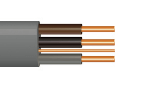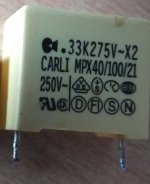So I have just fitted an LED bulb into a mains ceiling light fitting for my bro'.
The bulb glows dimly when the light is switched off indicating a small leakage current.
It is not the wall switches as it happens even if the wires in the switch are pulled.
It's a stair light so on 2 way switches.
Strangely, it only happens with the switches in one orientation.
The bulb is a fake filament type (I probably wouldn't have chosen it for stairs), I don't know if they are particularly sensitive to leakage current.
Any practical suggestions?
I suppose the first is try a different style of LED bulb.
The bulb glows dimly when the light is switched off indicating a small leakage current.
It is not the wall switches as it happens even if the wires in the switch are pulled.
It's a stair light so on 2 way switches.
Strangely, it only happens with the switches in one orientation.
The bulb is a fake filament type (I probably wouldn't have chosen it for stairs), I don't know if they are particularly sensitive to leakage current.
Any practical suggestions?
I suppose the first is try a different style of LED bulb.
Neutral and earth wires...check those.
With a meter as well.
And check with a real filament lamp, at least 40W, as well.
With a meter as well.
And check with a real filament lamp, at least 40W, as well.
Measure Volts for:
Phase-Neutral
Phase-Earth
Neutral-Earth.
Sometimes Neutral comes back through Earth.
I am assuming you do not have American style mains, where Neutral and Ground are tied together.
A Neutral-Earth voltage above 6 Volts is alarming in a 220V syatem.
So proceed with care.
Phase-Neutral
Phase-Earth
Neutral-Earth.
Sometimes Neutral comes back through Earth.
I am assuming you do not have American style mains, where Neutral and Ground are tied together.
A Neutral-Earth voltage above 6 Volts is alarming in a 220V syatem.
So proceed with care.
UK mains, Neutral is connected to Earth at the fusebox.
I am assuming that because this is the stair light, there will be a long cable running from the upstairs switch to the downstairs switch and there may be some capacitive coupling between cores.
If wired with 3 core and earth as attached pic you will see what I mean.
Brown (live feed) to black closely coupled, brown to grey, not so close.
Which possibly gives me an idea but I will have to ruminate to decide a) if it's safe and b) if it will work.
I am assuming that because this is the stair light, there will be a long cable running from the upstairs switch to the downstairs switch and there may be some capacitive coupling between cores.
If wired with 3 core and earth as attached pic you will see what I mean.
Brown (live feed) to black closely coupled, brown to grey, not so close.
Which possibly gives me an idea but I will have to ruminate to decide a) if it's safe and b) if it will work.
Attachments
It's not the bulb, it is the leakage current between wires, wall, etc. It depends on the exact configuration, and some CFL's also react that way. Some even flash: the leakage slowly charges the supply until the striking voltage is reached, at which point the converter starts and discharges the filter cap instantly.
After a few seconds or tens of seconds, the same cycle restarts again.
A possible solution, if the behaviour is deemed annoying, is to shunt the bulb with a lowish impedance. A resistor could work, but it would dissipate extra power in operation.
An X-rated cap, like 220n should have the same effect, without incurring active power losses
After a few seconds or tens of seconds, the same cycle restarts again.
A possible solution, if the behaviour is deemed annoying, is to shunt the bulb with a lowish impedance. A resistor could work, but it would dissipate extra power in operation.
An X-rated cap, like 220n should have the same effect, without incurring active power losses
Those filament types are really parallel LED strings (each filament is series LEDs) as per wattage, 4 strings means 4W, 6 strings is 6W, and so on.
Should not happen, they need about 90V to even glow.
Check with a meter...
Should not happen, they need about 90V to even glow.
Check with a meter...
Last edited:
Normal LED bulbs are driven by a R-C network, or a driver / SMPS.
The latest ones I have seen are driver on board designs, a diode bridge and chopper circuit are involved in the latter designs.
Like 'Rayma' says, check with a different bulb.
And I suggest use a meter as well.
The latest ones I have seen are driver on board designs, a diode bridge and chopper circuit are involved in the latter designs.
Like 'Rayma' says, check with a different bulb.
And I suggest use a meter as well.
Diode bridge wired like a DC blocker used in amplifiers and placed in series with the bulb will probably stop the problem. Not to code, however! IT might be a tool to diagnose the problem temporarily. Make sure bridge is rated to peak AC voltage.
Thanks Elvee.An X-rated cap, like 220n should have the same effect, without incurring active power losses
I guess either of these may work (from the scrap box). 100 or 330 nF, both 250V ac rated.
I'll try the small one first. May be a while before I report back.
UK 240V mains.
Attachments
White leds are usually made white by activating a phosphorus coating with blue light.
They can continue to glow without power.
They can continue to glow without power.
It should be OK: after all it only has to shunt a current of tens of µA, maybe one or two hundred at mostI'll try the small one first
👍Just try some different brands of bulbs.
https://www.liquidleds.com.au/blogs/news/why-do-led-bulbs-glow-after-the-power-is-switched-off
To test the leakage current hypothesis one could switch one bulb to an incandescent type. That'll drain whatever charge trickles through the leakage cap pretty efficiently.
I've never had issues with LED bulbs on switches. I do have issues with some LED bulbs on some dimmers. Sometimes they don't dim well. Other times they emit hum. It can be a bit of a gong show.
Tom
I've never had issues with LED bulbs on switches. I do have issues with some LED bulbs on some dimmers. Sometimes they don't dim well. Other times they emit hum. It can be a bit of a gong show.
Tom
I thought it was capacitive coupling between the cores, but I guess that’s covered by the term leakage. X- rated cap across the LED should fix it whatever
You are ignoring this important piece of data.It's a stair light so on 2 way switches.
Strangely, it only happens with the switches in one orientation.
In the preferred circut (there is more than one way to do it), bulb terminals (one of which is connected to aluminum case/heatsink) alternatively become Live or Neutral.
In one of those positions, I supect when center terminal is Live, and outer/heatsink is floating (open), capacitive coupling flows enough current through (a few microamoeres but Leds have become incredibly sensitive) to lightly turn them ON.
I have also seen Leds glow visibly when I am replacing a bulb.
Clearly in this case switch cuts Neutral and some current is capacitively coupling through my hand.
Later will add two ways to wire that staircase or corridor, one seems to be preferred in US (but not used here), the other what is popular in Argentina, because of a couple practical advantages.
Standard UK lighting for single switch is switch loops into ceiling fitting. Thus 2 cores, one live the second switched.
They are thus parallel for a few metres across the ceiling and down the wall.
The 2 way switch has a live feed from upstairs to the downstairs switch thus a longer cable run than other lights in the house.
The downstairs switch is a 3 gang switching 2 downstairs lights (with downstairs feed from fusebox) and the upstairs light (with upstairs feed from fusebox).
Separate breaker for upstairs and downstairs lights.
I could probably feed the upstairs light from the downstairs feed (within the 3 gang switch) thus breaking the coupling though this may or may not be to code.
They are thus parallel for a few metres across the ceiling and down the wall.
The 2 way switch has a live feed from upstairs to the downstairs switch thus a longer cable run than other lights in the house.
The downstairs switch is a 3 gang switching 2 downstairs lights (with downstairs feed from fusebox) and the upstairs light (with upstairs feed from fusebox).
Separate breaker for upstairs and downstairs lights.
I could probably feed the upstairs light from the downstairs feed (within the 3 gang switch) thus breaking the coupling though this may or may not be to code.
Much simpler to adopt a "symptomatic" treatment: 99% chances of success, quick, simple, and perfectly legit if you use a X type cap. Life is too short to burden yourself with non-existent problems.
In the unlikely case it doesn't work, you can always come back here to discuss an alternative solution, but I don't think it will be the case.
In addition, the cap will protect the lightbulb against surges, induced by lightning strikes for example. All benefit
In the unlikely case it doesn't work, you can always come back here to discuss an alternative solution, but I don't think it will be the case.
In addition, the cap will protect the lightbulb against surges, induced by lightning strikes for example. All benefit
- Home
- General Interest
- Everything Else
- LED room light glow when off


